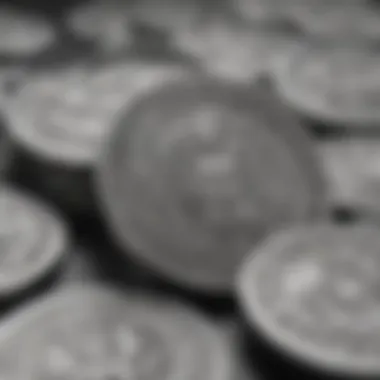Where to Buy Silver: Your Essential Purchasing Guide


Intro
Investing in silver offers a range of opportunities for both novice and experienced investors. The silver market, while often overshadowed by gold, has its own unique characteristics and considerations that impact its appeal. In this guide, we will explore the various avenues for purchasing silver, including both tangible and digital options. Understanding these avenues is pivotal in making informed investment decisions.
Silver has long been considered a valuable asset. It serves not only as a form of currency but also as a hedge against inflation. Many investors are increasingly looking to diversify their portfolios with precious metals like silver, which can be less volatile than other investment options such as stocks and bonds. With the increasing interest in silver, knowing where and how to buy it is essential for prospective buyers.
In the subsequent sections, we will define essential terms related to silver investing, outline strategies that can aid in making smart investments, and discuss the risks involved. By the end of this guide, you will have a clear understanding of the silver market and be well-equipped to proceed with your investment.
Investment Dictionary
Definition of Key Terms
- Bullion: Physical silver, usually in the form of bars or coins, that is traded based on its precious metal content.
- Spot Price: The current market price for immediate delivery of silver.
- Exchange-Traded Fund (ETF): A fund that holds silver assets and trades on stock exchanges like a stock.
- Liquidity: The ability to quickly sell an asset without significantly affecting its price.
Contextual Usage
Understanding these terms is critical when entering the silver market. Knowing what bullion is helps in recognizing the different forms of silver investment available. Recognizing the spot price will inform you about the cost of silver at any given time. Utilizing ETFs can provide exposure to silver prices without the need to own physical silver, appealing to those who prefer not to manage storage. Liquidity becomes crucial when determining how easily you can convert your holdings into cash.
Expert Advice
Investment Strategies
- Diversification: Do not put all your money into silver alone. Consider spreading investments across various asset classes.
- Long-Term Holding: Silver can be volatile in the short term, but historically, it tends to appreciate over a longer period.
- Regular Monitoring: Keep track of silver prices and market trends to make informed buying and selling decisions.
Risk Management Techniques
- Setting a Budget: Decide in advance how much you are willing to invest in silver to avoid overextending yourself.
- Buy During Dips: Consider purchasing silver when prices drop to maximize value.
- Stay Informed: Keep up-to-date with news and trends that affect silver prices to make better investment decisions.
"Investing in silver can be rewarding, but it is important to approach it with caution and knowledge."
With this foundational understanding, you are now prepared to explore where to procure silver effectively.
Prelude to Silver Investment
Silver is more than just a precious metal; it is a resilient asset class with a diverse array of applications. This section provides a foundation for understanding the role of silver in investment strategies. By examining silver’s different characteristics and uses, readers will be equipped to make informed decisions on whether to include it in their portfolios.
Understanding Silver as an Asset
Investing in silver presents unique advantages. Unlike stocks or bonds, silver holds intrinsic value. It is precious and finite, which adds stability during economic fluctuations. Moreover, silver is used in various industries, ranging from electronics to solar energy, further supporting its demand. This duality—both as a physical commodity and an industrial resource—enhances its appeal as a safe haven in volatile markets.
When considering silver for investment, it is crucial to note its liquidity. Physical silver can be converted to cash relatively easily, making it a practical choice for investors looking to maintain resources they can access quickly. The market for silver, while sometimes more unpredictable than gold, often experiences price increases during economic downturns, strengthening its role as a hedge.
Historical Context of Silver Investment
Silver has a long and storied history as a form of currency and investment. From ancient civilizations that used silver coins to modern investors purchasing silver bullion, its significance has evolved but remained substantial. The ability to store value is not a modern concept, and many cultures have relied on silver in times of uncertainty.
In the late 19th and early 20th centuries, the role of silver shifted due to the gold standard and the rise of fiat currencies. However, silver's historical use as a currency keeps it relevant, particularly in times of financial instability. Many investors look to silver not just for its potential appreciation but also for its historical reliability as a preservative measure against inflation and currency devaluation.
"Silver offers an opportunity not just as an investment, but as a reflection of economic change throughout history."
In summary, understanding silver as an asset involves exploring its intrinsic values and its historical context. This foundation will guide anyone interested in purchasing silver, whether for immediate investment or as a long-term financial strategy.
Why Invest in Silver?


Investing in silver has garnered attention for various reasons, ranging from financial security to industrial applications. Silver is not only a precious metal but also serves as a versatile asset. It tends to hold intrinsic value, making it a strategic choice, especially during economic uncertainty. This section unpacks the significance of silver investment, highlighting its diversification benefits, its ability to hedge against inflation, and the ongoing industrial demand that propels its use in modern technology.
Diversification Benefits
Diversification is crucial in any investment strategy. By incorporating silver into a portfolio, investors can reduce risk and enhance potential for growth. When financial markets fluctuate, silver often behaves differently from traditional assets like stocks or bonds. This variance can mitigate losses during periods of economic downturns. Silver prices do not always move in tandem with stock indices or real estate values. Instead, historical patterns reveal distinct movements that can protect investments.
Moreover, silver is a tangible asset. Physical ownership through coins or bars provides a sense of security to many investors. As part of a diversified investment strategy, silver can cushion against sector-specific downturns that affect stocks or real estate. This makes silver a valuable addition, especially in uncertain times.
Hedge Against Inflation
Inflation is an economic reality that erodes purchasing power over time. Silver has historically served as a hedge against inflation due to its intrinsic value. Unlike fiat currencies, which can be printed in limitless quantities, silver cannot be artificially manufactured. This scarcity ensures that silver retains its value as currencies lose purchasing power.
As inflation rises, so can the demand for tangible assets like silver. This relationship makes silver an appealing option for investors looking to preserve value. Purchasing silver allows investors to safeguard wealth, as it often increases in price during inflationary periods. For instance, various economic studies indicate a correlation between rising inflation rates and increased silver demand, emphasizing its role as a sound investment during such times.
Industrial Demand
Silver is not just an investment vehicle; it is also an essential industrial commodity. Various sectors, including electronics, solar energy, and healthcare, necessitate silver for manufacturing processes. The growth in green technologies, particularly solar panels, has notably increased the demand for silver. Its conductive properties make it invaluable in these applications.
Furthermore, as new technologies emerge, the need for silver in various industries is expected to rise. This ongoing demand can influence silver prices favorably, providing investors with growth opportunities. By understanding the industrial applications of silver, investors can appreciate the metal's dual role as a safe haven and a commodity.
Investing in silver offers numerous advantages. Its role in diversifying an investment portfolio, hedging against inflation, and supporting industrial demand solidifies its position as a smart investment choice.
Physical Silver Purchase Options
Understanding the physical silver purchase options available is crucial for investors seeking to add silver to their portfolios. This section outlines various avenues that individuals can use to acquire silver in tangible forms. The benefits of owning physical silver are many, including direct ownership, ease of access, and the ability to hold the asset securely. However, potential buyers should also consider factors such as authenticity, pricing, and storage requirements before making a purchase.
Local Coin Shops
Local coin shops are often a favored option for individuals looking to buy silver. These shops typically offer a range of products, from bullion coins to silver bars. The advantage of buying from a local shop includes the opportunity for immediate possession of the silver. That means no waiting for shipping or dealing with online transaction issues. Additionally, many local coin dealers are knowledgeable about the market and can provide insights into current prices and trends.
However, buyers should be cautious and ensure the shop is reputable. Checking online reviews or asking for recommendations can help. It's also important to note that prices at local coin shops may include premiums over the spot price of silver, so it is important to do research before committing to a purchase.
Online Precious Metal Dealers
Online dealers such as APMEX or JM Bullion are another popular option. These platforms allow for easy comparison shopping. Buyers can view a wide selection of products and prices, often at competitive rates. One of the major benefits of buying silver online is the convenience. Transactions can be done from anywhere at any time.
Before purchasing, it is wise to verify the credibility of the dealer. Look for customer reviews and check if they have secure payment options and clear return policies. It’s also important to be aware of shipping costs and delivery times. Online purchases might come with additional fees which can affect the overall costs.
Auction Houses
Auction houses provide a unique avenue for buying silver, especially rare coins or vintage pieces. This option can offer access to items that are not typically available in regular retail settings. Participating in auctions allows buyers the chance to acquire silver at potentially lower prices if bidding aligns favorably.
However, auction houses often charge fees for participation and successful bids, so prospective buyers should read the terms carefully. They should also consider whether they are comfortable with the auction process and the possibility of competitive bidding. Researching the specific auction house and understanding the consignment process is key to safeguarding against overpriced bids.
Government Mints
Purchasing directly from government mints, such as the United States Mint, is another reliable option. Mints produce official coins, which often come with a guarantee of authenticity and purity. These coins can be an excellent choice for customers, especially those new to silver investing. Buying from a mint also ensures that the products maintain high-quality standards.
Nevertheless, mints usually have a limited range of products available for sale and may have waiting periods for certain coins. The prices could also reflect marked premiums compared to spot prices, influenced by demand and the mint’s pricing policies. Keeping up with mint releases and understanding their offerings is important for enthusiastic collectors and investors.
"When investing in silver, consider factors such as premiums, authenticity, and the reliability of the source."
By exploring each of these physical silver purchase options, investors can better align their purchases with their goals and preferences, ultimately leading to a more informed decision-making process in their silver investment journey.
Paper Silver Investments


Investing in silver can take many forms, one of which is through paper silver investments. This approach is significant for those who may not want to deal with the physical aspects of owning silver. Paper silver investments provide exposure to the metal without requiring the actual possession of coins or bars. Investors can diversify their portfolios, minimizing the risks associated with physical storage and protection.
ETFs and Mutual Funds
Exchange-Traded Funds (ETFs) and mutual funds present a compelling way to invest in silver. ETFs, such as the iShares Silver Trust, allow investors to buy shares that are backed by physical silver. This means that each share represents a specific amount of silver stored in a secure location. ETFs offer liquidity, as shares can be bought and sold on the stock exchange during trading hours.
Unlike ETFs, mutual funds may not trade on an exchange and could involve a higher minimum investment. However, they often provide a diversified exposure to silver along with other precious metals. Both options come with management fees, but they allow investors to enter the silver market without the burdens of physical ownership.
Silver Futures and Options
Silver futures and options are derivatives that provide a way to speculate on the future price of silver. Futures contracts obligate the investor to buy or sell a specific amount of silver at a predetermined price on a set date. This can allow for significant profits, but also comes with high risks. Investors must have a good understanding of market volatility and timing with these types of investments.
Options, on the other hand, give the investor the right but not the obligation to buy or sell silver at a certain price before a specific date. This could be less risky compared to futures, as the maximum loss is limited to the premium paid for the option. However, it still requires a sound strategy and analysis to succeed in such investments.
Evaluating Silver Pricing
Evaluating silver pricing is a critical endeavor for anyone interested in silver investments. Understanding how prices are determined can make a significant difference in an investor's decision-making process. Investors must grasp the nuances of pricing in order to maximize returns and minimize risks. This section will break down key elements such as spot price, premiums, and market influences on price fluctuations. A well-rounded knowledge of these factors can aid both beginners and seasoned investors in making informed choices regarding their silver purchases.
Spot Price vs. Premiums
The spot price is essentially the current market price for an ounce of silver. It is the amount you would pay if you were to buy silver at that precise moment. Spot prices fluctuate and are influenced by factors like supply and demand, economic conditions, and market sentiments.
When discussing the purchase of physical silver, one must also consider premiums. A premium is the additional cost you pay over the spot price. This cost can be attributed to the dealer’s markup, minting costs, and the overall demand for specific products. Premiums can vary significantly depending on the form of silver being purchased.
- Types of Silver Products and Their Premiums:
- Bullion Bars: Generally have lower premiums.
- Coins: Often carry higher premiums due to numismatic value.
- Rounds: Similar to coins, they tend to have moderate premiums.
Understanding the relationship between spot price and premiums allows investors to analyze whether they are paying a fair price. If an investor buys silver bars at a low premium when the spot price is low, they could realize substantial savings. Investors must regularly check updated spot prices to make informed purchasing decisions.
Market Influences on Price Fluctuations
Silver prices do not exist in a vacuum. Various market influences play pivotal roles in shaping the price of silver. Important factors include:
- Economic Indicators: Interest rates, inflation rates, and economic growth figures can significantly impact prices. For instance, lower interest rates typically lead to higher silver prices as investors seek hedge against inflation.
- Geopolitical Events: Uncertainties in global markets often push investors toward precious metals like silver, increasing demand and driving prices upward.
- Supply and Demand Dynamics: A rise in industrial demand for silver, particularly from technology sectors, can lead to price increases. Conversely, if supply outstrips demand, prices may fall.
Investors should monitor these influences closely. Awareness of current events, economic reports, and market trends enables investors to predict price movements more accurately. Those who stay informed can position themselves advantageously in the marketplace.
"Knowledge and monitoring are essential in navigating the intricacies of silver investment."
In summary, evaluating silver pricing requires careful consideration of both the spot price and the accompanying premiums. Being aware of market forces and trends enhances an investor's understanding and aids them in making educated purchasing decisions.
Key Considerations Before Buying Silver
Buying silver can be a rewarding endeavor, yet it also carries significant responsibilities. Before making your purchase, it’s crucial to assess several key considerations that influence this investment. These considerations encompass authenticity, storage, and liquidity among others. Understanding these factors will not only help you make informed decisions but will also ensure the longevity and security of your investment.
Authenticity and Purity
Authenticity and purity are fundamental in the world of silver investment. Investors should verify that the silver they are purchasing is genuine and meets recognized purity standards. Silver is commonly measured in terms of fineness, with .999 being the standard for bullion products. When buying from dealers or shops, always ask for certificates or other verification methods.
Be cautious with online purchases, as fake products can easily circulate. Always utilize reputable dealers with strong track records. Research reviews and ratings from other buyers and ensure that the dealer is transparent about the products they sell.
"Verification of the product’s purity is vital for safeguarding your financial interests."


Storage Options
Where and how to store silver is another significant consideration. Silver is dense and heavy, which means it can take up considerable space. There are several options for storage. Firstly, you can keep your silver at home in a secure safe or lockbox. While this method allows for easy access, it also poses risks. Theft or loss can occur, and insurance may be necessary.
Alternatively, many investors choose to utilize safety deposit boxes at banks. They offer security and peace of mind, but there are fees involved. Some individuals opt for dedicated storage facilities that specialize in precious metals. This option usually provides optimal security along with insurance, albeit at a cost.
Liquidity Concerns
Liquidity refers to how easily you can sell your silver when needed. Not all silver investments are created equal in terms of liquidity. Physical silver, such as bars and coins, generally has good liquidity due to universal demand. However, selling may require extra time and effort, especially outside of regular market hours.
On the other hand, paper silver products like ETFs are often more liquid since they can be traded on the stock exchange during trading hours. The key is to consider your personal liquidity needs. If quick access to cash is important, you may want to weigh the benefits of paper investments against the tangible nature of physical silver.
In summary, assessing authenticity and purity, storage options, and liquidity before buying silver ensures that investors protect their investments. Each of these factors contributes to a more strategic approach, enhancing both the enjoyment and benefits of silver investing.
Legal and Tax Implications of Silver Investments
Understanding the legal and tax implications of silver investments is essential for any potential investor. These factors can significantly impact your overall returns. It is not just about acquiring silver; comprehension of the laws and tax regulations ensures that investors can navigate the silver market safely and profitably.
One crucial element is the tax treatment of investments and sales. It is vital to remain compliant with tax obligations to avoid penalties and ensure proper financial planning.
Additionally, regulatory considerations are also important. The framework governing precious metals can vary across regions. Recognizing these nuances will help investors make sound decisions and manage risk.
Tax Treatment of Silver Sales
When you sell silver, the profits you gain can be subject to capital gains tax. This tax varies based on how long you have held the silver. If you hold the silver for over a year, it is classified as a long-term capital gain, which generally has a lower tax rate compared to short-term capital gains.
- Long-Term Capital Gains: Profits from the sale of an asset held longer than a year. Tax rates can range from 0% to 20%, depending on your overall taxable income.
- Short-Term Capital Gains: Profits from assets held for less than a year. These gains are taxed at regular income tax rates, which can be considerably higher.
Here are some factors to consider:
- Record Keeping: Maintain detailed records of your purchases and sales. This will help in accurately reporting gains or losses.
- Tax Deductions: Some costs associated with buying and selling silver may be deductible, offering relief.
"Being aware of tax implications allows you to plan your investment strategy accordingly. This is crucial for maximizing your investment returns."
Regulatory Considerations
Compliance with regulations is important when dealing in silver. Depending on your country, there may be specific laws that govern the purchase, sale, and trade of silver. Here are some aspects to be aware of:
- Licensing Requirements: Some jurisdictions require dealers to have licenses. Understanding these requirements can protect you as a buyer.
- Reporting Requirements: Large transactions might need to be reported to authorities. Know the thresholds that would trigger mandatory reporting.
- Consumer Protection Laws: Many regions have laws that protect buyers from fraud. Familiarizing yourself with these laws can provide necessary safeguards.
Navigating the legal landscape of silver investments can be complex. Consulting with a financial advisor or tax professional can be beneficial to understand your obligations and ensure compliance with all legal requirements.
Culmination
Purchasing silver can be a transformative decision for many investors. This concluding section is critical, as it wraps up the comprehensive insights laid out previously in the article. The aim is to emphasize the key points and considerations needed when buying silver, whether in its physical form or through paper investments.
Investors should understand the differences in purchasing methods and pricing influences. Knowing the sources of buying silver, such as local coin shops, online dealers, or government mints, can lead to more informed decisions. Each option comes with its own distinct advantages and risks. Therefore, recognizing the foundational information shared in the earlier sections is vital to successfully navigate this market.
In addition, it is essential to grasp the implications regarding storage and authenticity. Silver storage methods differ and can impact long-term investment security. Make sure to also consider liquidity before making a purchase. Silver can be sold later, but the ease of liquidation may vary based on how it was acquired. Thus, keeping these factors in mind can enhance confidence in investments over time.
Finally, being aware of legal and tax implications is not just beneficial; it is necessary. Understanding tax treatments and regulatory factors can have a substantial financial impact. Investors should take these considerations seriously as they proceed in their silver-buying journey.
"Investing in silver is not just about securing a physical commodity, but about understanding the broader market and making informed choices."
Final Thoughts on Purchasing Silver
Reflecting on all the previous discussions, it becomes clear that purchasing silver requires careful planning and understanding. Markets can fluctuate, and seasonal trends may arise. Staying informed through reliable sources is key.
Moreover, investors should maintain flexibility in their strategies. Buyers need to remain open to learning and adjustments as they go. Yearning for knowledge, whether through communities like Reddit or financial sites like Britannica, can illuminate many paths.
Lastly, having a good grasp of one’s own financial position is crucial. Each individual's situation is unique. Therefore, the choices made with silver investments should align with personal financial goals and risk tolerance. This focus allows for a more tailored approach, enhancing the potential for successful outcomes in the silver market.















